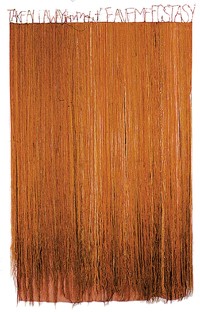For the past six years, Cynthia Thompson, the head of Memphis College of Art’s papermaking and book-arts department, has curated highly praised shows for the college dealing with subjects as wide-ranging as violence, faith, and race.
For “Above + Beneath,” her current and last curatorial project (she’s stepping down to concentrate on her own work and that of her students), Thompson brings together her love of words, textures, and eloquent abstraction. In this spare but compelling show, six New York artists explore the parameters of the human body with works that go as far above and as deep into the body as science and imagination can take them.
Lesley Dill, for instance, envisions Emily Dickinson’s rarefied, passionate poetry with Red Thread Fall. Thin filaments of wire at the top of this sculpture twist together to form a line from Dickinson’s poetry. It reads: “TAKE ALL AWAY FROM ME BUT LEAVE ME ECSTASY.” Cascading from these words are thousands of long, delicate threads in shades of gold and orange mixed with red. Dickinson has let down her hair.

Il Lee invites us to experience our bodies, feelings, and thoughts as one luminous whole. In his 46-by-60-inch untitled work on paper, thousands of strokes of a ballpoint pen become an iridescent ocean of purple-black ink. Set against untouched white paper, this piece can be read as the silhouette of a mountain beneath a pale sky. It’s also an abstraction evocative enough to be a Rorschach inkblot and saturate enough to be the sum of a viewer’s ballpoint pen doodles, grocery-store lists, love notes, and diary entries.
In this intensely personal yet monumental work, we see the individual strokes of the artist’s pen at the edges, and we feel the cumulative power within the large shape of thousands of gestures that make up a work of art or a human life.
Sarah Lovitt’s three small, untitled bas-reliefs hint at processes deep inside the human body. Some of the artist’s earlier works explored scars, wounds, tumors. For this show, pustule-like forms work their way almost to the surfaces of smooth, translucent wax molds. Lovitt’s studies of the fragile but resilient body’s ability to release toxins and to heal are simultaneously disturbing and hopeful.
On a lighter note, photographer Gary Schneider “gunked-up” his hands and created what could be a portrait of the artist as playful child with the Midas touch (Genetic Self Portrait: Hands). Heat- and sweat-sensitive film emulsions (photograms) appear gritty and black where Schneider imprinted his hands. In stark contrast, light reflecting off his fingertips resembles whirlpools of gold. Here is the artist (gritty with dirt or grease or photo-emulsions) curious, digging into things, and bringing them into the light. With both hands raised, palms wide open, Schneider appears to exclaim, “Hey, look at this!”
Theresa Chong, an accomplished cellist as well as a nationally noted visual artist, charts the twists and turns of her own creative process. Graphite lines accented with touches of gouache white flow rhythmically, switch back, dead end, and go in unexpected new directions. Up close, Chong’s points of light on dark blue rice paper bring to mind synapses, electrical circuits, and insights forming deep within a psyche (Fred I, CNS, and Light 6 #1). Viewed at a distance, they look like night skies dense with stars.
Paper sculptor Noriko Ambe dissolves boundaries of “above” and “beneath.” She describes the experience of cutting into and layering hundreds of sheets of vellum-like paper as “melting into the natural world.” Viewing Ambe’s work produces a similar effect. The thin, staggered ledges surrounding the open center of Linear Action Cutting Project #7 resemble wide-mouthed chasms cut by water for millions of years. Their translucent, smooth surfaces also suggest shifting sand dunes, deposits of shale in an ancient sea bed, and, like the proverbial onion peel, layers of our own skin and psyche.
Is “melting into the natural world” too esoteric and dramatic a claim? As we are gently and incrementally drawn into an artwork remarkable for its power to evoke myriad visceral responses within its 11-by-14-by-1-inch boundaries, the artist’s descriptions of disappearing into nature begin to make sense.